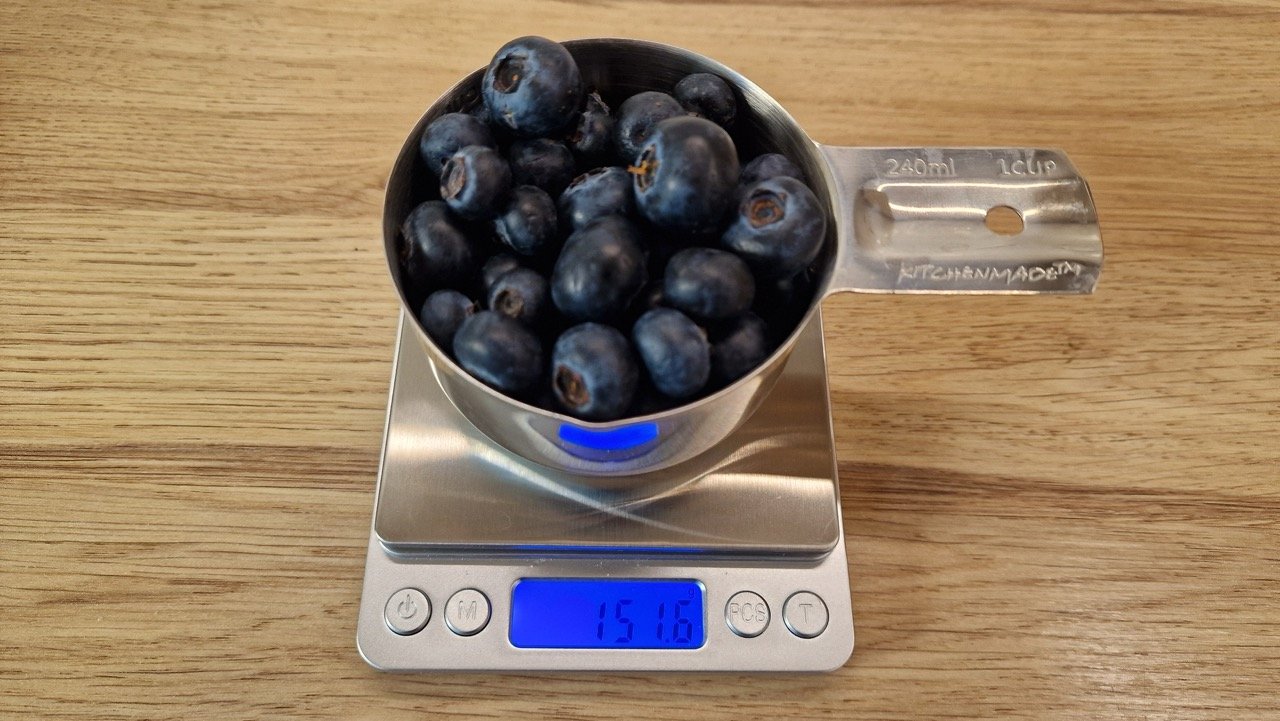In both baking and cooking, the precision of ingredient measurements can greatly influence the outcome of a recipe. For ingredients like blueberries, which can be used fresh, frozen, dried, or even pureed, understanding how to measure them accurately is crucial.
This guide explores the nuances of measuring blueberries in various units such as cups, grams, and ounces, offering insights to help maintain consistency and achieve perfect results in your culinary creations.
Understanding Blueberry Measurements
Overview of Common Measurement Units
- Cups: A standard measurement in American kitchens, cups are often used for volume-based recipes.
- Grams: Preferred in most professional and some home kitchens outside the U.S., grams offer precision for weight-based recipes.
- Ounces: Another weight-based measure, commonly used in the U.S.
- Tablespoons: Useful for when smaller quantities of blueberries are needed, such as in garnishes or small batch recipes.
Why Blueberries Are Tricky to Measure
Blueberries vary greatly in size and density, which can impact volume and weight. Freshness and moisture content also play a critical role; freshly picked blueberries might be juicier and heavier, whereas store-bought ones could be slightly dehydrated and lighter. These variations make it challenging to get consistent measurements without the right techniques.
Practical Measurement Tips
How to Measure Blueberries Accurately
- Using Kitchen Scales: For the most accurate results, especially when using grams or ounces, kitchen scales are indispensable. Ensure the scale is calibrated and place the blueberries gently to avoid extra weight from settling.
- Proper Way to Fill a Measuring Cup: To measure blueberries in cups, pour them into the cup and gently shake to allow them to settle without compacting. This method helps reduce air gaps and provides a more accurate volume measure.
Adjusting Recipes
Slight variations in blueberry measurements can alter the texture and flavor of a dish. If a recipe is too wet due to extra blueberries, reduce the amount of other liquid ingredients slightly. Conversely, if the dish is too dry, a bit more liquid might be needed. Understanding these adjustments can help you tailor recipes to your taste and ensure consistent results every time.
Nutritional Benefits of Blueberries
Blueberries are not only a delicious addition to various dishes but also packed with essential nutrients and health benefits. They are a rich source of:
- Vitamins: Particularly high in vitamin C and K, which help with immune function and blood clotting.
- Minerals: Contains manganese, essential for bone development and nutrient absorption.
- Antioxidants: Blueberries are renowned for their high levels of antioxidants, which combat free radicals and may reduce the risk of chronic diseases.
-
Fiber: Helps in maintaining gastrointestinal health and enhancing satiety, which is beneficial for weight management.
Including blueberries in your diet can contribute to heart health, improve brain function, and help maintain blood sugar levels within a healthy range, making them a superfood worth measuring right.
Blueberry Conversion Tables And Formulas
Most Common Conversions for Blueberry
- 1 teaspoon of blueberry: 3 grams.
- 1 tablespoon of blueberry: 9 grams.
- 1 US cup of blueberry: 150 grams.
- 1 UK cup of blueberry: 156 grams.
Blueberry US Cups to Grams and Ounces
| US Cups of blueberry | Amount in grams (g) | Amount in ounces (oz) |
|---|---|---|
| 1/8 cup | 19 g | 0.66 oz |
| 1/4 cup | 38 g | 1.32 oz |
| 1/3 cup | 50 g | 1.76 oz |
| 3/8 cup | 56 g | 1.98 oz |
| 1/2 cup | 75 g | 2.65 oz |
| 5/8 cup | 94 g | 3.31 oz |
| 2/3 cup | 100 g | 3.53 oz |
| 3/4 cup | 113 g | 3.97 oz |
| 7/8 cup | 131 g | 4.63 oz |
| 1 cup | 150 g | 5.29 oz |
| 2 cups | 300 g | 10.58 oz |
| 3 cups | 450 g | 15.87 oz |
| 4 cups | 600 g | 21.16 oz |
| 5 cups | 750 g | 26.46 oz |
| 6 cups | 900 g | 31.75 oz |
| 7 cups | 1050 g | 37.04 oz |
| 8 cups | 1200 g | 42.33 oz |
| 9 cups | 1350 g | 47.62 oz |
| 10 cups | 1500 g | 52.91 oz |
Blueberry UK Cups to Grams and Ounces
| UK Cups of blueberry | Amount in grams (g) | Amount in ounces (oz) |
|---|---|---|
| 1/8 cup | 20 g | 0.69 oz |
| 1/4 cup | 39 g | 1.38 oz |
| 1/3 cup | 52 g | 1.84 oz |
| 3/8 cup | 59 g | 2.07 oz |
| 1/2 cup | 78 g | 2.76 oz |
| 5/8 cup | 98 g | 3.44 oz |
| 2/3 cup | 104 g | 3.67 oz |
| 3/4 cup | 117 g | 4.13 oz |
| 7/8 cup | 137 g | 4.82 oz |
| 1 cup | 156 g | 5.51 oz |
| 2 cups | 313 g | 11.02 oz |
| 3 cups | 469 g | 16.53 oz |
| 4 cups | 625 g | 22.05 oz |
| 5 cups | 781 g | 27.56 oz |
| 6 cups | 938 g | 33.07 oz |
| 7 cups | 1094 g | 38.58 oz |
| 8 cups | 1250 g | 44.09 oz |
| 9 cups | 1406 g | 49.6 oz |
| 10 cups | 1563 g | 55.12 oz |
Blueberry Tablespoons to Grams and Ounces
There is now real practical use in measuring blueberry with a tablespoon. However, for complete conversion rates we give you the theoretical tablespoon measurements in grams.
| Tbsp of blueberry | Amount in grams (g) | Amount in ounces (oz) |
|---|---|---|
| 1/4 tbsp | 2 g | 0.08 oz |
| 1/3 tbsp | 3 g | 0.11 oz |
| 1/2 tbsp | 5 g | 0.17 oz |
| 1 tbsp | 9 g | 0.33 oz |
| 2 tbsp | 19 g | 0.66 oz |
| 3 tbsp | 28 g | 0.99 oz |
| 4 tbsp | 38 g | 1.32 oz |
| 5 tbsp | 47 g | 1.65 oz |
| 6 tbsp | 56 g | 1.98 oz |
| 7 tbsp | 66 g | 2.31 oz |
| 8 tbsp | 75 g | 2.65 oz |
| 9 tbsp | 84 g | 2.98 oz |
| 10 tbsp | 94 g | 3.31 oz |
Blueberry Teaspoons to Grams and Ounces
There is now real practical use in measuring blueberry with a teaspoon. However, for complete conversion rates we give you the theoretical teaspoon measurements in grams.
| Tsp of blueberry | Amount in grams (g) | Amount in ounces (oz) |
|---|---|---|
| 1 tsp | 3 g | 0.11 oz |
| 2 tsp | 6 g | 0.22 oz |
| 3 tsp | 9 g | 0.33 oz |
| 4 tsp | 13 g | 0.44 oz |
| 5 tsp | 16 g | 0.55 oz |
| 6 tsp | 19 g | 0.66 oz |
| 7 tsp | 22 g | 0.77 oz |
| 8 tsp | 25 g | 0.88 oz |
| 9 tsp | 28 g | 0.99 oz |
| 10 tsp | 31 g | 1.1 oz |
Metric vs. Imperial Conversions
When working with blueberry in the kitchen, it's essential to be adept at converting between the metric and imperial systems of measurement. This skill ensures accuracy in following recipes from different culinary traditions around the world.
The metric system, commonly used around the world, measures blueberry primarily in grams and kilograms. This system is favored for its simplicity and ease of scaling.
Predominantly used in the United States, the imperial system measures blueberry in tablespoons and teaspoons. While not as straightforward as scaling, it is deeply integrated into many traditional American recipes.
Common Measurement Units for Blueberry
Blueberry can be measured by either volume or weight. Ingredients that come in large pieces, such as blueberry, are the worst to be measured by volume (e.g. cups). Cups measurement for blueberry are very unreliable, different measurements can differ by even more than 20%. Use a kitchen scale instead for precise measurement.
Most typical volume measurements for blueberry are:
- Teaspoons (tsp)
- Tablespoons (tbsp)
- Cups
Most typical weight measurements for blueberry are:
- Ounces (oz)
- Grams (g)
- Kilograms (kg)
- Pounds (lbs)
How We Measure Blueberry?
To make sure that our conversion rates are correct, we don't just copy data from other websites. We actually take at least 5 different measurements of 1 cup of blueberry and use the average for calculations and conversion tables. Read more on our measurement methodology by clicking on this link.

